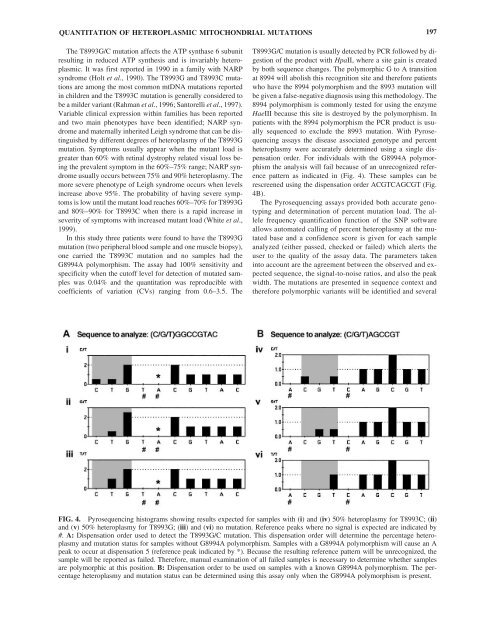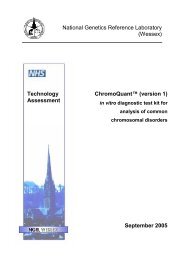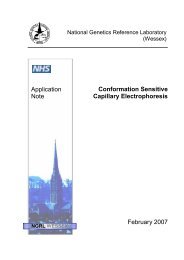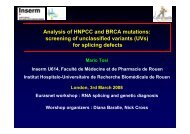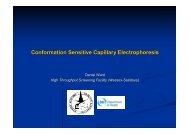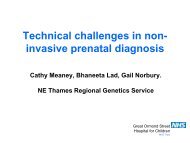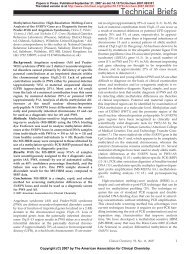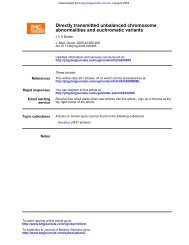QUANTITATION OF HETEROPLASMIC MITOCHONDRIAL MUTATIONS 197The T8993G/C mutation affects the ATP synthase 6 subunitresulting in reduced ATP synthesis <strong>and</strong> is invariably heteroplasmic.It was first reported in 1990 in a family with NARPsyndrome (Holt et al., 1990). The T8993G <strong>and</strong> T8993C mutationsare among the most common mtDNA mutations reportedin children <strong>and</strong> the T8993C mutation is generally considered tobe a milder variant (Rahman et al., 1996; Santorelli et al., 1997).Variable clinical expression within families has been reported<strong>and</strong> two main phenotypes have been identified; NARP syndrome<strong>and</strong> maternally inherited Leigh syndrome that can be distinguishedby different degrees <strong>of</strong> heteroplasmy <strong>of</strong> the T8993Gmutation. Symptoms usually appear when the mutant load isgreater than 60% with retinal dystrophy related visual loss beingthe prevalent symptom in the 60%–75% range; NARP syndromeusually occurs between 75% <strong>and</strong> 90% heteroplasmy. Themore severe phenotype <strong>of</strong> Leigh syndrome occurs when levelsincrease above 95%. The probability <strong>of</strong> having severe symptomsis low until the mutant load reaches 60%–70% for T8993G<strong>and</strong> 80%–90% for T8993C when there is a rapid increase inseverity <strong>of</strong> symptoms with increased mutant load (White et al.,1999).In this study three patients were found to have the T8993Gmutation (two peripheral blood sample <strong>and</strong> one muscle biopsy),one carried the T8993C mutation <strong>and</strong> no samples had theG8994A polymorphism. The assay had 100% sensitivity <strong>and</strong>specificity when the cut<strong>of</strong>f level for detection <strong>of</strong> mutated sampleswas 0.04% <strong>and</strong> the quantitation was reproducible withcoefficients <strong>of</strong> variation (CVs) ranging from 0.6–3.5. TheT8993G/C mutation is usually detected by PCR followed by digestion<strong>of</strong> the product with HpaII, where a site gain is createdby both sequence changes. The polymorphic G to A transitionat 8994 will abolish this recognition site <strong>and</strong> therefore patientswho have the 8994 polymorphism <strong>and</strong> the 8993 mutation willbe given a false-negative diagnosis using this methodology. The8994 polymorphism is commonly tested for using the enzymeHaeIII because this site is destroyed by the polymorphism. Inpatients with the 8994 polymorphism the PCR product is usuallysequenced to exclude the 8993 mutation. With Pyrosequencingassays the disease associated genotype <strong>and</strong> percentheteroplasmy were accurately determined using a single dispensationorder. For individuals with the G8994A polymorphismthe analysis will fail because <strong>of</strong> an unrecognized referencepattern as indicated in (Fig. 4). These samples can berescreened using the dispensation order ACGTCAGCGT (Fig.4B).The Pyrosequencing assays provided both accurate genotyping<strong>and</strong> determination <strong>of</strong> percent mutation load. The allelefrequency quantification function <strong>of</strong> the SNP s<strong>of</strong>twareallows automated calling <strong>of</strong> percent heteroplasmy at the mutatedbase <strong>and</strong> a confidence score is given for each sampleanalyzed (either passed, checked or failed) which alerts theuser to the quality <strong>of</strong> the assay data. The parameters takeninto account are the agreement between the observed <strong>and</strong> expectedsequence, the signal-to-noise ratios, <strong>and</strong> also the peakwidth. The mutations are presented in sequence context <strong>and</strong>therefore polymorphic variants will be identified <strong>and</strong> severalFIG. 4. Pyrosequencing histograms showing results expected for samples with (i) <strong>and</strong> (iv) 50% heteroplasmy for T8993C; (ii)<strong>and</strong> (v) 50% heteroplasmy for T8993G; (iii) <strong>and</strong> (vi) no mutation. Reference peaks where no signal is expected are indicated by#. A: Dispensation order used to detect the T8993G/C mutation. This dispensation order will determine the percentage heteroplasmy<strong>and</strong> mutation status for samples without G8994A polymorphism. Samples with a G8994A polymorphism will cause an Apeak to occur at dispensation 5 (reference peak indicated by *). Because the resulting reference pattern will be unrecognized, thesample will be reported as failed. Therefore, manual examination <strong>of</strong> all failed samples is necessary to determine whether samplesare polymorphic at this position. B: Dispensation order to be used on samples with a known G8994A polymorphism. The percentageheteroplasmy <strong>and</strong> mutation status can be determined using this assay only when the G8994A polymorphism is present.
198reference peaks are also incorporated into the analysis thatadd confidence to the data collection. This provides additionalbenefit compared to PCR-RFLP or techniques that relyupon hybridization where false-positive <strong>and</strong> -negative resultscan be obtained in patients with polymorphisms that disruptthe hybridization or restriction enzyme sites or where incompleterestriction enzymes digestion can occur (e.g., Kirbyet al., 1998, White et al., 1998). The Pyrosequencing assayswere easy to design <strong>and</strong> optimise <strong>and</strong> sample processing <strong>and</strong>use <strong>of</strong> the machine were straightforward. The incorporation<strong>of</strong> new <strong>and</strong> existing mutations into mitochondrial point mutationscreening would be relatively undem<strong>and</strong>ing with theadvantage that the assays would not have to be designed toinclude restriction enzyme sites. The platform is very flexible<strong>and</strong> is amenable to the analysis <strong>of</strong> either individual mutationsin single wells or the analysis <strong>of</strong> multiple samplesfor the same mutation within the same run. This is anadvantage over PCR-RFLP where different, <strong>and</strong> sometimesmultiple, restriction digests are required for the analysis <strong>of</strong>each mutation. Pyrosequencing is more sensitive <strong>and</strong> rapidcompared to fluorescent PCR-RFLP with costings for eachtechnique being similar. We conclude therefore that Pyrosequencingis a robust, effective, <strong>and</strong> efficient means <strong>of</strong> detecting<strong>and</strong> quantifying mitochondrial mutations in a clinicallaboratory setting.REFERENCESBai RK, Wong LJ. <strong>Detection</strong> <strong>and</strong> quantification <strong>of</strong> heteroplasmic mutantmitochondrial DNA by real-time amplification refractory mutationsystem quantitative PCR analysis: A single-step approach. ClinChem, 50:996–1001, 2004.Boles RG, Chaudhari D, Soderkvist J, et al. Quantification <strong>of</strong> mitochondrialDNA heteroplasmy by temporal temperature gradient gelelectrophoresis. Clin Chem, 49:198–200, 2003.Chinnery PF, Howell N, Lightowlers RN, et al. Molecular pathology<strong>of</strong> MELAS <strong>and</strong> MERRF. The relationship between mutation load<strong>and</strong> clinical phenotypes. Brain, 120:1713–1721, 1997.Ciafaloni E, Ricci E, Shanske S, et al. MELAS: clinical features,biochemistry, <strong>and</strong> molecular genetics. Ann Neurol, 31:391–398,1992.Conley YP, Brockway H, Beatty M, et al. Qualitative <strong>and</strong> quantitativedetection <strong>of</strong> mitochondrial heteroplasmy in cerebrospinal fluid usingdenaturing high-performance liquid chromatography. Brain ResBrain Res Protoc, 12:99–103, 2003.DiMauro S, Schon EA. Nuclear power <strong>and</strong> mitochondrial disease. NatGenet, 19:214–215, 1998.Hancock DK, Schwarz FP, Song F, et al. Design <strong>and</strong> use <strong>of</strong> a peptidenucleic acid for detection <strong>of</strong> the heteroplasmic low-frequency mitochondrialencephalomyopathy, lactic acidosis, <strong>and</strong> stroke-likeepisodes (MELAS) mutation in human mitochondrial DNA. ClinChem, 48:2155–2163, 2002.He L, Chinnery PF, Durham SE, et al. <strong>Detection</strong> <strong>and</strong> quantification <strong>of</strong>mitochondrial DNA deletions in individual cells by real-time PCR.Nucleic Acids Res, 30:e68, 2002.Holt IJ, Harding AE, Petty RK, et al. A new mitochondrial disease associatedwith mitochondrial DNA heteroplasmy. Am J Hum Genet,46:428–433, 1990.Huoponen K, Vilkki J, Aula P, et al. A new mtDNA mutation associatedwith Leber hereditary optic neuroretinopathy. Am J Hum Genet,48:1147–1153, 1991.WHITE ET AL.Johns DR, Neufeld MJ, Park RD. An ND-6 mitochondrial DNA mutationassociated with Leber hereditary optic neuropathy. BiochemBiophys Res Commun, 187:1551–1557, 1992.Juvonen V, Huoponen K, Syvanen AC, et al. Quantification <strong>of</strong> pointmutations associated with Leber hereditary optic neuroretinopathyby solid-phase minisequencing. Hum Genet, 93:16–20, 1994.Kirby DM, Milovac T, Thorburn DR. A false-positive diagnosis for thecommon MELAS (A3243G) mutation caused by a novel variant(A3426G) in the ND1 gene <strong>of</strong> mitochondria DNA. Mol Diagn,3:211–215, 1998.Lagerström-Fermér M, Olsson C, Forsgren L, et al. Heteroplasmy <strong>of</strong>the human mtDNA control region remains constant during life. AmJ Hum Genet, 68:1299–1301, 2001.Liang MH, Wong LJ. Yield <strong>of</strong> mtDNA mutation analysis in 2,000 patients.Am J Med Genet, 77:395–400, 1998.Macmillan C, Lach B, Shoubridge EA. Variable distribution <strong>of</strong> mutantmitochondrial DNAs (tRNA(Leu[3243]) in tissues <strong>of</strong> symptomaticrelatives with MELAS: The role <strong>of</strong> mitotic segregation. Neurology,43:1586–1590, 1993.Mashima Y, Nagano M, Funayama T, et al. Rapid quantification <strong>of</strong> theheteroplasmy <strong>of</strong> mutant mitochondrial DNAs in Leber’s hereditaryoptic neuropathy using the Invader technology. Clin Biochem,37:268–276, 2004.Mashima Y, Saga M, Hiida Y, et al. Quantitative determination <strong>of</strong> heteroplasmyin Leber’s hereditary optic neuropathy by single-str<strong>and</strong>conformation polymorphism. Invest Ophthalmol, Vis Sci 36:1714–1720, 1995.Rahman S, Blok RB, Dahl HH, et al. Leigh syndrome: clinical features<strong>and</strong> biochemical <strong>and</strong> DNA abnormalities. Ann Neurol, 39:343–351,1996.Ronaghi M, Uhlén M, Nyrén P. A sequencing method based on realtimepyrophosphate. Science, 281:363–365, 1998.Santorelli FM, Tanji K, Shanske S, et al. Heterogeneous clinical presentation<strong>of</strong> the mtDNA NARP/T8993G mutation. Neurology,49:270–273, 1997.Silvestri G, Ciafaloni E, Santorelli FM, et al. Clinical features associatedwith the A G transition at nucleotide 8344 <strong>of</strong> mtDNA(“MERRF mutation”). Neurology, 43:1200–1206, 1993.Suomalainen A, Syvanen AC. Quantitative analysis <strong>of</strong> human DNA sequencesby PCR <strong>and</strong> solid-phase minisequencing. Mol Biotechnol,15:123–131, 2000.Szuhai K, Ouwel<strong>and</strong> J, Dirks R, et al. Simultaneous A8344G heteroplasmy<strong>and</strong> mitochondrial DNA copy number quantification in myoclonusepilepsy <strong>and</strong> ragged-red fibers (MERRF) syndrome by amultiplex molecular beacon based real-time fluorescence PCR. NucleicAcids Res, 29:E13, 2001.Tanno Y, Yoneda M, Tanaka K, et al. <strong>Quantitation</strong> <strong>of</strong> heteroplasmy <strong>of</strong>mitochondrial tRNA(Leu(UUR)) gene using PCR-SSCP. MuscleNerve, 18:1390–1397, 1995.Thornburn DR, Dahl H-HM. <strong>Mitochondrial</strong> disorders: Genetics, counseling,prenatal diagnosis <strong>and</strong> reproductive options. Am J Med Genet,106:102–114, 2001.Tully LA, Parsons TJ, Steighner RJ, et al. A sensitive denaturing gradient-Gelelectrophoresis assay reveals a high frequency <strong>of</strong> heteroplasmyin hypervariable region 1 <strong>of</strong> the human mtDNA control region.Am J Hum Genet, 67:432–443, 2000.Urata M, Wada Y, Kim SH, et al. High-sensitivity detection <strong>of</strong> theA3243G mutation <strong>of</strong> mitochondrial DNA by a combination <strong>of</strong> allelespecificPCR <strong>and</strong> peptide nucleic acid-directed PCR clamping. ClinChem, 50:2045–2051, 2004.Wallace DC, Singh G, Lott MT, et al. <strong>Mitochondrial</strong> DNA mutationassociated with Leber’s hereditary optic neuropathy. Science,242:1427–1430, 1988.Wallace DC. <strong>Mitochondrial</strong> diseases in man <strong>and</strong> mouse. Science,283:1482–1488, 1999.


